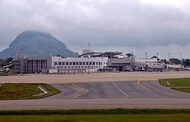NIGERIA’s economy grew at an annual rate of 2.55 percent in the three months to December, 2019; the National Bureau of Statistics has reported.
The rate, which is its highest quarterly growth since a 2016 recession, came on the heels of 0.27 per cent expansion in the previous quarter and 0.17 per cent in the same period a year earlier.
Growth rose to an annual rate of 2.28 percent in the third quarter after production of its main export, crude oil, rose to a more than three-year high. Crude production in the fourth quarter stood at 2 million barrels per day, up from 1.91 million in the same period of the previous year, the statistics office said.
The Federal Government welcomed the positive growth trajectory of the economy with Adeyemi Dipeolu, special adviser to the president on Economic Matters, saying in a statement: “The Gross Domestic Product (GDP) grew by 2.55 per cent (year-on year), in Q4 2019. This reflects an increase of 0.17 per cent over Q4 2018 (2.38%). This figure is also an increase of 0.27% compared to the preceding quarter (Q3 2019). Aggregate GDP stood at N39.5trillion while in real terms, GDP is at N19.53trillion in Q4 2019.
The growth in Q4 2019 is the highest rate since Nigeria came out of the recession in 2017. This feeds into the estimated overall GDP growth for 2019 which is 2.27%. This represents an increase on 2018’s growth rate of 0.36%, and shows an improving trend since the recession, of increasing growth in GDP. The non-oil sector contributed 92.68% to GDP in the period with the oil sector contributing 7.32%. While the oil sector has seen an undulating trend over the past few years, the non-oil sector has a more stable and slightly upward growth trajectory. The non-oil sector’s contribution is on the back of Agriculture 26.1%, Industries 20.27%, and Services 53.64%.
In the oil sector, average production was 2million barrels per day (2mbpd) in Q4 2019. The important thing to note is that production remained consistently around this range in 2019. The real growth of the oil sector in Q4 2019 was 6.36% year-on-year (6.49% in Q3 2019). For 2019, the oil sector recorded growth of 4.59% (0.97% in Q4 2018). The non-oil sector grew by 2.26% in real terms in Q4 2019. This is a slight reduction compared with 2.7% in Q4 2018, but higher than 1.82% in the previous quarter. The growth in the non-oil sector is driven by Information and Communication Technology, Agriculture, Manufacturing and Financial and Insurance Services. Agriculture grew by 13.8% in Q4 2019, which is lower than 18.58% and 14.88% recorded in Q4 2018 and Q3 2019. Sector contribution is 22.12% which is higher than recorded in 2018. Real growth in the sector was 2.31% (year-on-year).
In Manufacturing, the growth is 26.29 percent for the period, which is less than 33.57 percent and 39.69 percent in Q4 2018 and Q3 2019 respectively. Sector contribution is 11.37 percent, which is higher than the same period in 2018. Real GDP growth was 1.24 percent (year on year)The Information and Communication Sector (Telecommunication mainly) recorded growth of 9.86 percent in the period which is lower than 14.82 percent and 10.99 percent in Q4 2019 and Q3 2018 respectively. Sector contribution in 2019 was 10.68 percent which is higher than the same period in 2018. Real GDP growth was 8.5 percent. Finance and Services sector grew at 23.3 percent in nominal terms. This is higher than the preceding quarter and the similar period in 2018. The Sectors annual contribution in 2019 was 2.93 percent. In real terms, this growth was at 20.18 percent. Economic growth is reflective of a healthy economy and points to the policies of government towards specific priority sectors. The report shows that Nigeria is growing, even higher than some international analysts had predicted.
This growth can be attributed to the robust policies of the government to diversify the economy, renewed security efforts/reduced vandalism of pipelines, and improved consumption/production of local goods (Rice) etc. Overall, the Nigerian economy performed reasonably despite external shocks, internal issues (border closure), tightening of monetary policy, and the Central Bank of Nigeria’s continued defense of the Naira. There is also some improvement expected going forward with less volatility in oil prices, reduced effect of disease on crops (Lassa fever), more support to SMEs, early passage of the budget and continued diversification of the economy.”
Afrinvest in a flash note to investors on the growth said “The performance in Q4:2019 brings FY:2019 economic growth rate to 2.3 percent, an improvement from 1.9 percent in 2018 and over our revised forecast of 2.2 percent. Considering that growth is still short of long-term and population growth rates of 7.1 percent and 2.7 percent, there is little to cheer. The oil sector increased its contribution to growth in 2019, expanding 4.6 percent from 1.0 percent in 2018, following stability in the Niger-Delta and new output from the EGINA FPSO. In this regard, oil production rose 5.0 percent to an average of 2.0mb/d in 2019. The non-oil sector remained the major driver of growth as it improved 2.1 percent in 2019, although this was little changed from 2.0 percent in 2018. Aside the ICT and agriculture sectors, there was a broad-based underperformance in major sub-sectors. In our view, this suggests that the economic recovery would continue at a sluggish pace without the implementation of reforms and market-friendly policies.
“The underlying reasons for the sluggish performance of the non-oil sub-sectors buttress our point. In the services sector, there was a faster expansion of 2.6% Y-o-Y in Q4:2019 from 1.9% in the previous quarter while growth was 2.2% in FY:2019 from 1.8% in 2018. While the ICT sector sustained its remarkable expansion, the trade and real estate sectors (22.1% of GDP) remained in a recession, although somewhat improving. In our view, the unfriendly trade policies of the government continues to affect the pace of recovery. In the real estate sector, aside the weak macroeconomic environment, poor investment in housing, the lack of flexible regulations around land use and registration as well as expensive and slow approvals of building permits are critical factors.
“More so, in the agriculture sector, growth was faster at 2.4% in 2019 from 2.1% in 2018, but weaker than its long-term average of 3-4.0%. Beyond cheap credit, there has been little progress towards boosting agriculture yields, helping farmers adapt to a changing climate and curbing insecurity. In manufacturing, the weakness in consumer purchasing power remains the major theme as growth slowed to 0.8% in 2019 from 2.1% in 2018. On the other hand, the financial services sector surged 22.3% in Q4:2019, the highest growth recorded in a quarter. Similarly, the sector grew faster at 2.4% in 2019 from 1.4% in 2018. We suspect this was driven by the raft of policies rolled out by the CBN in H2:2019, particularly the 65.0% increase in Loan-to-deposit ratio. We retain our growth forecast of 2.4% for 2020 as we do not expect significant improvements”.














